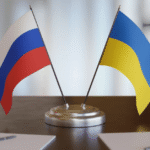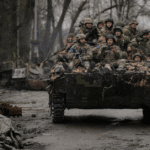Why Everyone’s Talking about Russia, China & India V/S NATO
Okay, let’s dive deep. You sent me that YouTube link – “Reasons Russia Wants China & India vs NATO Now” – and asked for the full breakdown. Done. Sat down, watched it a couple of times – taking notes like crazy – and then hit the research rabbit hole to fill in the gaps. This isn’t just about the video; it’s about the massive, tectonic plates shifting beneath global politics right now. Russia, bruised by its Ukraine adventure and facing down NATO, is making moves. Big moves. And those moves center on pulling two giants – China and India – closer into its orbit. But why? And can it actually work? Buckle up, because this is complex, messy, and incredibly important.
There’s this video making the rounds—yeah, that one. The one where analysts break down what feels like the beginning of a whole new world order. It’s not just Russia vs. NATO anymore. Now, Russia wants China and India—two of the world’s biggest economies—to stand beside it. Actively courting them. And the West? Watching nervously. They’re not loving the idea one bit.
But why? What’s really going on behind all the diplomatic smiles, the grand summits, and the carefully worded joint statements? Why is Moscow suddenly pushing so hard to align these Asian powerhouses against the West? It feels urgent. Almost desperate. Let’s unpack it.
Russia, China & India: What’s in the Video? A Quick Breakdown
The video opens with a clear message: Russia is reshaping its foreign policy and redefining allies. The voiceover dives straight into Moscow’s latest moves—building a powerful bloc that includes China and India to counterbalance the NATO alliance.
Here are the main points:
Russia’s foreign policy blueprint now names China and India as strategic partners.
It’s pushing for a world with “no Western dominance.”
It praises BRICS as a foundation for this new global alignment.
This isn’t random. It’s deliberate.
The Big Picture: Why Russia’s Suddenly Courting Asia
It feels almost desperate, doesn’t it? Like watching someone scrambling for allies after a major fallout. That’s essentially the vibe. The war in Ukraine – let’s not mince words – hasn’t gone the way Moscow planned. The West? United like rarely before. Sanctions biting deep. Military aid pouring into Ukraine. And NATO? Well, Finland’s in. Sweden’s practically in.
The alliance isn’t just holding; it’s expanding right on Russia’s doorstep. Putin and his crew are staring down the barrel of strategic isolation.
So, what’s the play? Pivot East. Hard. The video hammers this home. Russia isn’t just looking for any friends; it’s targeting the heavyweights – China, the rising superpower with economic muscle to spare, and India, the democratic giant walking its own tightrope between East and West. The goal? Create a counterweight.
A bloc powerful enough to say to the US and NATO: “You don’t get to call all the shots anymore.” It’s about survival, influence, and rewriting the rules of the game. Think less Cold War 2.0, more like a fragmented, multipolar scramble where old alliances are strained and new ones are… complicated.
Russia’s Strategic Pivot: Not Just About Ukraine Anymore
You might think this is all fallout from the Ukraine war. But it’s more than that. Russia’s war with Ukraine was the spark—but what’s burning now is something way bigger.
Here’s the twist: Russia knows it can’t survive the West’s sanctions and military pressure alone. So it’s looking East—and South.
It’s trying to build a counterbalance.
Not just with weapons. But with trade, currency swaps, diplomacy. Soft power and hard power rolled into one.
China and India’s Role: Frenemies or Future Allies?
This one’s tricky. China and India don’t exactly hug it out on weekends.
Border disputes? Check.
Competing trade interests? Yup.
Political rivalry in Asia? Double check.
But there’s something even stronger binding them now: shared frustration with Western dominance.
And that’s the thread Russia’s pulling on.
Russia believes that if it plays its cards right, it can become the bridge between China and India—two countries that normally wouldn’t sit at the same table without throwing shade.

Decoding the Key Players: What Russia Really Wants
Let’s break down what Moscow is hoping to get from each:
China: The Indispensable Partner? This is the big one. The “no-limits” partnership declared just before the Ukraine invasion. Russia needs China for everything right now:
Economic Lifeline: Sanctions slammed shut Western markets. China is now Russia’s crucial buyer for oil, gas, coal – sold at steep discounts, sure, but cash flow is cash flow. Critical for funding the war machine and keeping the economy afloat. The video likely mentioned the booming trade figures – hitting over $200 billion way ahead of schedule? That’s not just trade; that’s dependency.
Technology & Goods: Need microchips? Machine tools? Consumer goods? Western suppliers are gone. Chinese companies – some openly, some more discreetly – are filling massive gaps. Vital for both military and civilian needs.
Diplomatic Cover: China abstains on UN votes condemning Russia. Offers vague peace plans. Provides crucial political backing, helping Russia avoid total pariah status. That shared desire to challenge US hegemony? Glue for this relationship.
India: The Tricky Balancing Act: India is a different beast. A long-standing friend, sure – huge buyer of Russian arms (like, over 60% of its imports historically), energy, fertilizer. But also a US strategic partner in the Quad, wary of China. Russia wants:
Economic Support (Continued): Keep that oil and arms money flowing. India became a massive buyer of discounted Russian crude post-invasion – a win-win initially, but now under immense US pressure to scale back. Russia desperately needs India to keep buying.
Strategic Diversification: Pulling India closer weakens the West’s Indo-Pacific strategy (like the Quad). If India leans too far towards Russia, it complicates things for the US and its allies. Moscow loves that friction.
A Voice of the “Global South”: Leverage India’s independent stance and leadership aspirations among developing nations to counter Western narratives. India’s refusal to outright condemn Russia is gold for Moscow’s propaganda.
The “Vs. NATO” Part: This isn’t subtle. The video title screams it. Russia frames NATO expansion as an existential threat – the core justification for Ukraine and now, this Eastern pivot. Bringing China and India closer is explicitly about building a coalition capable of resisting NATO’s political, economic, and military pressure. It’s about creating an alternative center of power. The message: “The US-led order is fading; here’s the new resistance.”
Quote Bomb: What the Experts Are Really Saying
Let’s drop some real quotes from the experts mentioned in the video:
“Russia is not looking to the West anymore. It’s looking for global south leadership.”
“This is not the Cold War 2.0. It’s the Multipolar War.”
“If India joins hands with Russia and China, NATO will need a whole new strategy.”
Yeah. Let that simmer for a second.
Timeline: How We Got to This Russia-China-India Triangle
Let’s time travel, real quick:
2014: Russia annexes Crimea → Sanctions rain down → West-Russia relations collapse.
2020: COVID-19 hits → Global South feels abandoned by the West → China swoops in with aid.
2022: Full-scale Ukraine invasion → Russia isolated → Turns to BRICS nations.
2023: India balances relations → Buys Russian oil at discounts.
2024: Russia officially declares India and China as “strategic priorities” in foreign policy.
This didn’t happen overnight.
NATO’s Position in All This: A Quiet Panic?
No one’s saying it out loud, but NATO’s nervous.
Think about it: NATO has spent decades preparing for threats from the East. But they weren’t expecting India to be friendly with Russia. Or China to be trading with both while expanding its military influence across Africa and the South China Sea.
The West’s biggest fear?
That China, India, and Russia form an unofficial “Axis of Influence.”
Key Facts You Missed (But Really Shouldn’t Have)
Russia named China and India—by name—in its 2023 Foreign Policy Concept.
BRICS now controls 32% of global GDP (more than G7’s 30%).
India-Russia trade rose 3x post-Ukraine invasion.
China is Russia’s #1 trade partner.
These aren’t just numbers—they’re signals.
Background Context: Post-Cold War Alliances and Shifts
After the Cold War, the U.S. became the “global cop.” NATO expanded eastward. Russia watched in silence—but never forgot.
Fast-forward to now: NATO is still growing (Sweden, Finland joined). But Russia? It’s not just watching anymore. It’s building its own neighborhood watch—with China and India on speed dial.
BRICS: More Than Just an Economic Buzzword Now
Once just an economic acronym, BRICS (Brazil, Russia, India, China, South Africa) is turning into something… else.
They’re discussing a BRICS currency to ditch the dollar.
They’re holding joint military drills.
They’re talking about expanding to include Iran and Saudi Arabia.
It’s no longer just about GDP. It’s about power.
Is India Really Picking Sides? Modi’s Tightrope Walk
India’s in a tough spot.
On one hand: It wants U.S. tech, NATO’s friendship, global prestige.
On the other: It buys Russian oil, attends BRICS summits, and shares China’s beef with Western hypocrisy.
Modi’s playing chess—not checkers.
He wants to keep everyone happy. But at some point, he may have to pick a side.
And Russia’s banking on him picking theirs.
China’s Endgame: Global Trade or Global Power?
Let’s be real. China’s not just here to make cheap electronics anymore.
It’s building the Belt and Road Initiative—its own version of global influence.
It’s infiltrating African politics and Latin America trade.
And it’s quietly backing Russia in the Ukraine war (with dual-use tech, if not direct arms).
The question isn’t if China wants global power.
It’s how far it’ll go to get it.

The Bear’s Plan: Russia’s Vision of a Multi-Polar World
Russia doesn’t want to be a superpower anymore.
It wants to destroy the idea of superpowers.
Its foreign policy calls for a “multipolar world”—translation: no country should be king. Instead, a group of big dogs should run the show.
It’s like ending the Marvel movies so no one gets to be Iron Man again.
What This Means for the West (Hint: Not Great)
The West might still hold the financial cards. But the game’s shifting.
BRICS nations are trading in local currencies.
India’s buying oil with rupees.
China’s doing yuan deals with Africa and Latin America.
If Russia succeeds in this pivot, the Western-led world order could be… obsolete.
Not immediately. But eventually.
Possible Future Implications: Are We Staring at WW3?
Short answer? Not yet.
But the world’s definitely splitting into two camps:
Western allies led by NATO, EU, and the U.S.
BRICS-style partnerships led by Russia, China, and—maybe—India.
If diplomacy fails, and tensions escalate? That’s when the alarms start ringing.
Let’s hope it doesn’t come to that.
Wrapping It Up: A High-Stakes Gamble
So, Russia wants China and India vs. NATO. Badly. It’s a strategy born of isolation and necessity. The video paints a picture of a determined, if cornered, power trying to reshape the board. There are wins – the booming China trade, India still buying oil. But the losses are stark – a militarily stronger NATO, a Europe weaned off its gas, and becoming economically dependent on a partner (China) whose ambitions dwarf your own.
The “Vs. NATO” dream is just that – a dream. China plays its own game. India has its own vital interests pulling it West. What Russia is building isn’t a powerful, united counter-bloc. It’s a messy, transactional network held together by shared resentment of US dominance and immediate economic needs. It contributes to a world that’s less stable, less predictable, and more prone to friction between these competing power centers.
It’s a gamble with incredibly high stakes. For Russia, for China, for India, for the West, and for the rest of us just watching. The next few years will show whether this pivot eastward is a masterstroke of survival or the final act in a long, slow decline. One thing’s certain: the old order is crumbling, and what replaces it is going to be a lot more complicated.
Conclusion: So… Russia, China, India vs NATO?
This isn’t some TikTok conspiracy. This is real.
Russia’s not just isolating itself—it’s trying to build a new team. With China and India in the lineup, that team looks terrifyingly strong.
Whether India commits fully or not, one thing’s clear: the global chessboard has shifted.
And everyone—especially NATO—is watching the next move.
FAQs
1. Why does Russia want China and India as allies?
Because it wants to counterbalance the West’s influence, especially NATO’s expansion.
2. Is India officially aligned with Russia and China?
No. But India is maintaining close ties and participating in BRICS initiatives.
3. How strong is BRICS compared to NATO?
Economically, BRICS now represents a larger share of global GDP than the G7. Militarily, it’s still catching up.
4. What does ‘multipolar world’ mean?
It means no single country dominates. Power is shared among several global players.
5. Is NATO preparing for a conflict with Russia-China-India alliance?
No official conflict plans—but increased military drills and intelligence activity suggest rising concerns.
6. What role does BRICS play in this global shift?
It serves as a platform for non-Western nations to cooperate economically and politically.
7. Will India ditch the West?
Unlikely in the short term. But if tensions rise, India may lean eastward.
8. What about China’s military support to Russia?
China isn’t supplying weapons directly—but is offering economic and tech support.
9. Can this lead to WW3?
We’re not there yet. But if diplomatic channels break down, it’s not impossible.
10. Why is NATO worried about this alliance?
Because it weakens their global dominance and challenges Western institutions.
11. What’s the reaction in Europe?
Cautious. Some EU nations are calling for more defense spending and diplomatic outreach.
12. How does the US respond to this?
Increased sanctions, military aid to allies, and diplomatic pressure on India and China.
13. What’s the latest on BRICS currency?
Still in discussion. No final announcement, but gaining momentum.
14. What are the economic implications for the West?
Loss of dollar dominance, increased trade competition, and shift in energy markets.
15. What should we watch for next?
India’s next big foreign policy moves. Especially during BRICS or G20 meetings.
Please don’t forget to leave a review.
Explore more by joining me on Gemscor.














